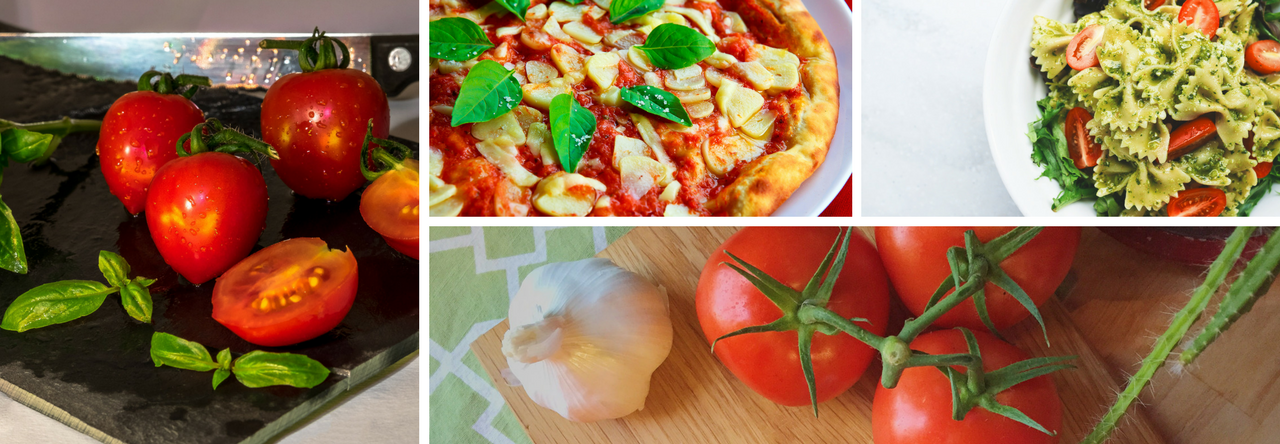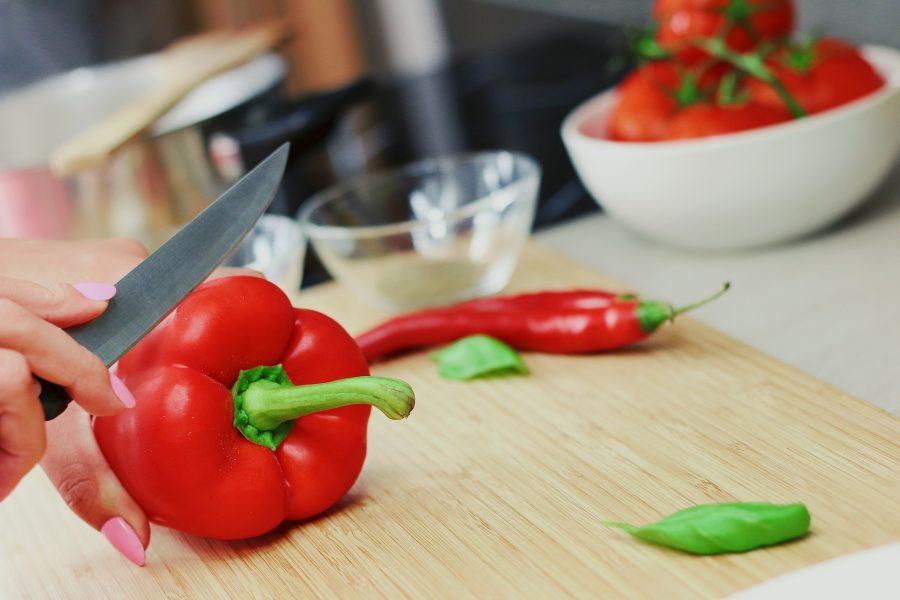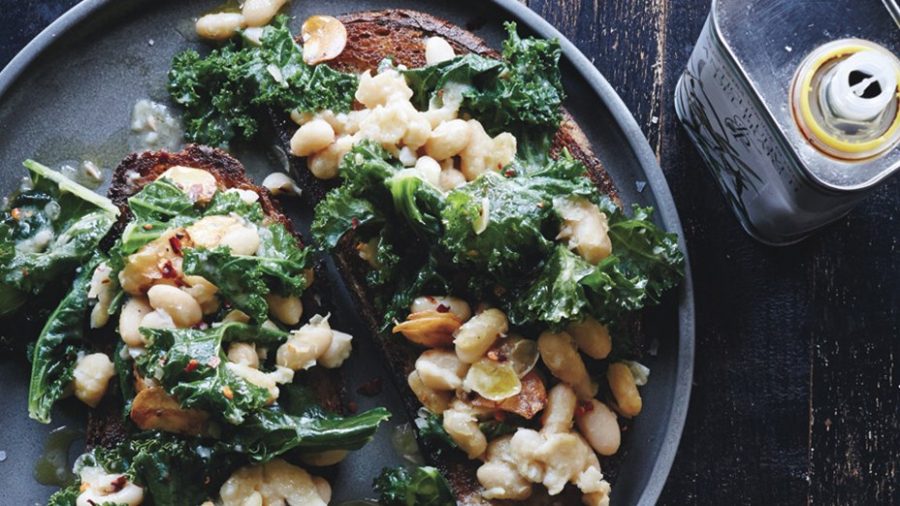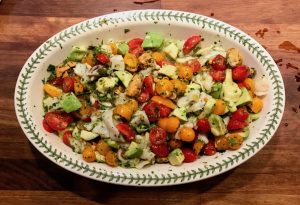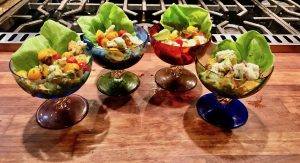Octopus Salad alla Vucciria (for 4 to 6 people)
In my previous posting of how to cook octopus for soup, I suggested that it’s best to get a small octopus, because large octopus is too rubbery. My good friend Giancarlo Gottardo taught me how to make even a large octopus tender and delicious. Most American fish markets can provide you with fresh octopus, and they usually clean the inner organs, leaving the head and tentacles.
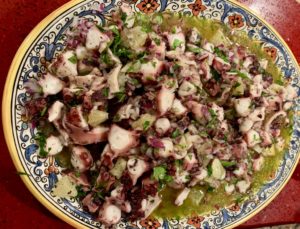
Michele’s version of the Polpo alla Vucciria
The Vucciria is the most famous open market in Palermo, Sicily. Traditionally, the fishmongers there beat the octopus against marble counters to tenderize it, then cook it in large pots. When shoppers approach the counters, the fishmongers chop the octopus and serve it with a wedge of lemon. This recipe is Giancarlo’s elegant variation of the fresh, simple preparation of the Sicilian fish mongers.
The Vucciria is the most famous open market in Palermo, Sicily. Traditionally, the fishmongers there beat the octopus against marble counters to tenderize it, then cook it in large pots. When shoppers approach the counters, the fishmongers chop the octopus and serve it with a wedge of lemon. This recipe is Giancarlo’s elegant variation of the fresh, simple preparation of the Sicilian fish mongers.
Ingredients
- ½ to 1 cup of course sea salt
- 1 large octopus – about 2.2 pounds
- 6 whole lemons: 2 for juicing, and 4 which will be chopped for the salad
- A handful of fresh Italian parsley, minced
- 1 medium red onion, cut into thin slices
Dressing:
- Juice two lemons
- Extra Virgin Italian olive oil, approximately ¼ cup. The ratio of lemon juice to olive oil should be 1:1 (in other words, if the juice from the two lemons is ½ cup, mix it with ½ cup of extra virgin olive oil)
- 2-3 TB of white vinegar, preferably white balsamic vinegar
- 1 TB. fine sea salt
- 1 teaspoon black pepper
Preparation
- Put the octopus into a large pan or bowl. Rub the coarse sea salt over the entire body of the octopus, massaging the salt into the skin for about 10 minutes. You will see a foamy liquid start to release from the body. Cover the pan and place the salt-covered octopus in the refrigerator for four hours.(Note: If you need to prepare this recipe a day ahead, you can complete the brining process on one day, then cook it the next day. The key is that you cannot brine the octopus longer than four hours. Once the four hours are up, you can rinse the octopus very well as described in step 3, then store in an airtight container until the next day, when you cook it, starting at step 4)
- While you wait for the brining process to complete, make the dressing and put it into a jar that you can shake to mix the ingredients just prior to serving the salad.
- After 4 hours of brining, put the octopus into a colander in your sink and rinse it very well with cold water, making sure all the salt has been washed from the skin.
- Place the rinsed octopus into a heavy pan and cover with cold water, making sure that all the tentacles are covered with water. Cook at a low temperature for 2 hours, until the meat is tender.
- Remove the octopus from pot and allow to cool on a large cutting board. Chop the octopus into half-inch pieces. If the octopus’s beak is still present, use a sharp knife to remove the beak.
- While the octopus is cooling, slice or chop the red onion. Peel the 4 lemons and cut into small pieces, avoiding the seeds and the rind. Put them into a large serving bowl and add the minced parsley.
Italiano: Insalata di Polipo (per 4 -6 persone)
Nella mia ricotta su come cucinare il polpo, ho detto che è meglio prendere un piccolo polpo, perché il grande polpo è troppo gommoso. Il mio buon amico Giancarlo Gottardo mi ha insegnato come rendere tenero e delizioso anche un grande polpo. La maggior parte dei mercati ittici americani può fornirti polpi freschi e di solito puliscono gli organi interni, lasciando la testa e i tentacoli.
Ingredienti
- 2 -3 pugni sale marino, grosso
- 1 polpo tra 1 – 1.5 kili
- 6 limoni interi: 2 per la spremitura e 4 che verranno tritati per l’insalata
- Una manciata di prezzemolo fresco italiano, tritato
- 1 cipolla rossa media, tagliata a fettine sottili
Salsa:
- Succo di due limoni
- Olio extra vergine di oliva italiano, circa ¼ di tazza. Il rapporto tra succo di limone e olio d’oliva dovrebbe essere 1: 1 (in altre parole, se il succo dei due limoni è ½ tazza, mescolarlo con ½ tazza di olio extra vergine di oliva)
- 2-3 cucchiai di aceto bianco, preferibilmente aceto balsamico bianco
- 1 cucchiaio di sale marino fine
- 1⁄4 cucchiaio di pepe nero
Come Prepare Questa Ricetta
- Coprite il polpo con un paio di pugni di sale e lasciate riposare in frigo 1 ora.
- Sciacquate bene, coprite con acqua fredda, mettete un coperchio pesante cosi che tutto il polpo è sott’acqua, tentacoli compresi, e cuocete a fuoco basso 2 ore, finchè tenero (più è grosso il polpo più ci vuole e viceversa).
- Tritate il polpo a pezzettini piccoli col coltello, tritate finemente una cipolla rossa media e mezzo mazzo di prezzemolo, e 4 limoni tagliati a fettine sottili e poi tritati –niente semi ne bianco ne buccia. Mischiate il tutto.
- Salsa: sugo di due limoni, mischiate 1:1 con olio d’oliva (cioè lo stesso volume di limone e di olio), 2-3 cucchiai di aceto bianco, sale e pepe.
- Mischiare la salsa con il polipo e portare subito a tavola.

